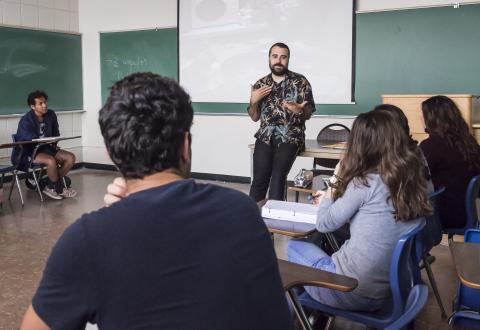You can document your effectiveness and growth as a teacher in a teaching philosophy statement, a teaching statement, by analyzing student feedback from surveys or by creating a teaching portfolio. As you document your teaching, consider the following key questions for self reflection.
Key Questions for Self-Reflection
-
What aspects of your teaching, or students’ learning, have you been focusing your efforts on?
-
How did you structure the course(s), and why?
-
What teaching innovations have you explored or tried, and why?
-
What have you discovered about your teaching, or students’ learning, and how did you discover it (i.e. sources of evidence)? This might include teaching challenges, barriers to learning , aspects of teaching that are helping students’ learn , new teaching approaches in your field), and so on that you gleaned from surveys, analysis of student data, and/or teacher professional development.
-
How have you contributed to teaching and learning at your organization, beyond classroom teaching?

Teaching Philosophy Statements
Your Teaching Philosophy Statement (TPS) describes your approach to teaching based on your values, beliefs about how students learn best (in your teaching context) and experience. It gives readers a window into what it feels like to be a learner in your classes and how you reflect and grow as a teacher; these statements are often required on job applications for teaching positions in higher education. Consider integrating your answers to the following in your TPS, which is typically 1-2 pages long:
-
I believe that “students learn best when _____”
-
What broad goals do I have for my students?
-
How do I teach to facilitate that learning (e.g. instructional practices/strategies)?
-
Are these strategies working? How do I know? (e.g. evidence of teaching and learning effectiveness)
-
What are my future goals for growth as a teacher?

We host quarterly workshops for TAs on Writing Teaching Philosophy Statements and provide feedback on Teaching Philosophy Statements, by request.
Teaching Statements
Teaching Statements allow you to summarize your teaching experiences, highlight teaching innovations, discuss challenges and describe your teaching professional development in a succinct (1-2 pages) narrative. These reflective statements are often required for advancement in teaching careers and are most useful to reviewers when they illustrate key points with specific examples and describe how you assess and revise your practices over time.

Teaching statements often include the following sections:
-
Introduction (overview of courses taught; rationale/approach to teaching during review period)
-
Context (discipline/department, course sizes, types, students, etc.)
-
Description of pedagogical/mentoring activities, innovations, etc. This may include course innovations, contributions to diversity via teaching/mentoring, professional learning, development, and/or research that contributes to or reflects activities
-
Evidence of teaching effectiveness and reflection (using ESCI and other available feedback)
UCSB provides the following guidance and resources for writing Teaching Statements for faculty merit cases.
-
Expectations for teaching of faculty and lecturers are outlined in the Red Binder.
-
UCSB’s Committee on Academic Personnel (CAP)
UCSB’s Teaching and Learning Division’s Guidance on Components of Teaching Self-evaluation (by ID/CITRAL)
Analyzing Student Surveys and ESCI Reports
Analyzing student feedback on teaching, such as mid-quarter surveys and course evaluations (ESCIs) can help you better understand students’ experiences in your course. Use the following resources to help identify aspects of your teaching and course that students find most helpful or challenging. They will help you find themes in open-ended comments and investigate trends over time.
-
First, look for broad patterns across all of the survey questions: Which questions do students rate most and least favorably?
-
Next, consider questions that you care the most about; these might reflect your teaching values or aspects of your teaching that you’ve been working on.
-
Reflect on why students might be rating the questions identified in parts 1 and 2 as they did. Note your own explanations before you investigate student comments for their perspective.
-
Scan student feedback for common themes and important outliers.
-
First, look for broad patterns across all of the survey questions: Which questions do students rate most and least favorably?
-
First, look for broad patterns across all of the survey questions: Which questions do students rate most and least favorably?
-
Next, consider questions that you care the most about; these might reflect your teaching values or aspects of your teaching that you’ve been working on.
-
Reflect on why students might be rating the questions identified in parts 1 and 2 as they did. Note your own explanations before you investigate student comments for their perspective.
>
Next, consider questions that you care the most about; these might reflect your teaching values or aspects of your teaching that you’ve been working on.
-
Reflect on why students might be rating the questions identified in parts 1 and 2 as they did. Note your own explanations before you investigate student comments for their perspective.
- >
To avoid being unduly influenced by extreme (negative or positive) comments, consider counting how many positive, neutral and negative comments were offered.
-
Make note of students' suggestions that you’d like to incorporate into your class or discuss with students.
-
Finally, consider how your perceptions of the course vary from students’ perceptions and how any misalignment might be explained.
UCSB’s Evaluation System for Courses and Instruction (ESCI) aggregates student feedback in end-of-quarter reports and 5-year summary reports. These reports display numerical distributions for closed-ended questions and allow you to compare these results to typical ratings in other courses using “normative data.” Use the following resources to guide your analysis of course evaluation reports.
Teaching Portfolios
Teaching portfolios allow you to narrate your approach to teaching and include artifacts to illustrate your claims. Assembling a teaching portfolio can help you to identify your teaching strengths and document how you’ve addressed teaching challenges. You can give prospective employers and review committees a window into your teaching by sharing your portfolio with them.

-
Make your organization obvious to your viewer. Whether you’re designing a website for your teaching portfolio or writing it as a document, be sure to include a linked overview/table of contents to allow viewers to explore it non-linearly.
-
Be particular about the teaching artifacts that you include. Curating a small set of compelling materials that represent important facets of your teaching, across the range of courses that you teach, is more effective than including a lot of disparate materials.
-
Link to and describe each artifact that you include in your teaching portfolio. This will help the reader see the artifact as “evidence” for claims that you make about your teaching. For example, if you discuss active learning as an important component of your teaching, you might link to a sample lesson plan and feedback from students.
The essentials
-
Teaching Philosophy Statement describing the values and beliefs that inform your teaching practices.
-
Teaching Statement (overview of teaching experience and growth)
-
A list of courses taught/TAed, with enrollments, and a description of your responsibilities
-
Design of new courses
-
Design of interdisciplinary or collaborative courses or teaching projects
-
Number of advisees, graduate and undergraduate
-
Optional artifacts (include those that are most meaningful to you)
-
Course Artifacts
-
Syllabi
-
Course website (link to LMS or screenshots)
-
Course descriptions with details of content, objectives, methods, and procedures for evaluating student learning
-
Innovative methods of teaching, assessing learning or grading
-
Handouts, advance organizers
-
Description of how technology is used to enhance learning
-
Video excerpts of your teaching
-
-
Teaching Effectiveness
-
Analysis of student evaluations of teaching
-
Insights from peer review of teaching
-
Materials demonstrating student learning/performance (e.g. pre/post tests, samples of student work, sample instructor feedback)
-
Insights from participation in seminars or professional meetings on teaching
-
Description of instructional improvement projects developed or carried out
-
-
Contributions to the Teaching Profession/UCSB
-
Publications in teaching journals
-
Papers/talks/workshops given on teaching
-
Preparation (or review) of a textbook, lab manual, courseware, etc.
-
Service on teaching-related committees (e.g. curriculum planning committees, CCUT Faculty Advisory Board)
-
Assistance to colleagues on teaching
-
-
Honors, Awards, or Recognitions
-
Teaching awards from department, university, professional organizations
-
Invitations based on teaching reputation to consult, give workshops, write articles, etc.
-
Requests for advice on teaching by committees or other organized groups
-
Information adapted from https://cft.vanderbilt.edu/guides-sub-pages/teaching-portfolios/